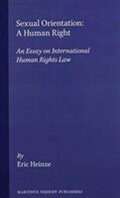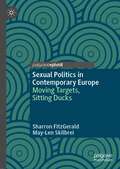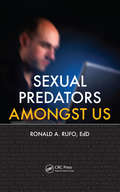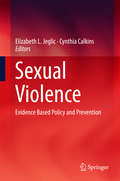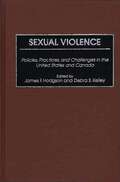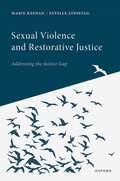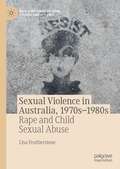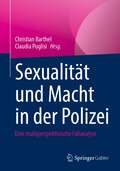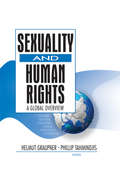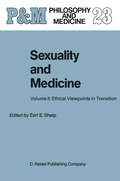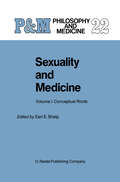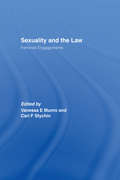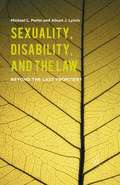- Table View
- List View
Sexual Orientation, Gender Identity and International Human Rights Law: Common Law Perspectives (Human Rights and International Law)
by Kerry O'HalloranThis book identifies, analyses and discusses the nexus of legal issues that have emerged in recent years around sexuality and gender. It audits these against specific human rights requirements and evaluates the outcomes as evidenced in the legislation and caselaw of six leading common law jurisdictions. Beginning with a snapshot of the legal definitions and sanctions associated with the traditional marital family unit, the book examines the subsequently evolving key concepts and constructs before outlining the contemporary international framework of human rights as it relates to matters of sexuality and gender. It proceeds by identifying a set of themes, including the rights to identity, to form a family, to privacy, to equality and to non-discrimination, and undertakes a comparative evaluation of how these and other themes indicate areas of commonality and difference in the approaches adopted in those common law jurisdictions, as illustrated by the associated legislation and caselaw. It then considers why this should be and assesses the implications.
Sexual Orientation, Gender Identity and International Human Rights Law: Common Law Perspectives (Human Rights and International Law)
by Kerry O'HalloranThis book identifies, analyses and discusses the nexus of legal issues that have emerged in recent years around sexuality and gender. It audits these against specific human rights requirements and evaluates the outcomes as evidenced in the legislation and caselaw of six leading common law jurisdictions. Beginning with a snapshot of the legal definitions and sanctions associated with the traditional marital family unit, the book examines the subsequently evolving key concepts and constructs before outlining the contemporary international framework of human rights as it relates to matters of sexuality and gender. It proceeds by identifying a set of themes, including the rights to identity, to form a family, to privacy, to equality and to non-discrimination, and undertakes a comparative evaluation of how these and other themes indicate areas of commonality and difference in the approaches adopted in those common law jurisdictions, as illustrated by the associated legislation and caselaw. It then considers why this should be and assesses the implications.
Sexual Orientation - A Human Right: An Essay on International Human Rights Law
by Eric HeinzeThis book is the first to examine sexual orientation from the viewpoint of international human rights law. It does not simply `create' a platform of rights and argue for their `introduction' in human rights law. Rather, it examines how extant international norms should be construed to include rights against discrimination on the basis of sexual orientation, including rights of privacy, equality, speech, expression, and association. It raises questions of cultural relativism, religious faith, social science, and legal theory. It will be of interest to international jurists, human rights organizations, gay rights organizations, constitutional scholars, and anyone interested in expanding the role of international human rights law as a formidable adversary of persecution and discrimination throughout the world.
Sexual Politics in Contemporary Europe: Moving Targets, Sitting Ducks
by May-Len Skilbrei Sharron FitzGeraldThe legal regulation of gender and sexuality has undergone dramatic changes throughout Europe in the last 40 years and this has shaped what it means to be a European citizen. Drawing on a range of interdisciplinary research, this book uses the discourses around current European sexual politics as an entry point to interrogate how, and with what effect, the EU and its Member States harness issues of gender and sexuality to support issues of higher political importance. It takes recent and ongoing political debates and legislative changes around prostitution and sexual assault as a focus. Using four national case studies: Poland, Germany, Sweden and Italy it illuminates how the EU’s desire for increased harmonisation across the Union around gender and sexuality norms and values operates differently and with specific effects across Member States. The book’s structure provides a detailed map of how and why contemporary European sexual politics is changing, and how this contributes to establishing European norms and values in developments in law and policy around prostitution and sexual assault. By examining how and why the EU and its Member States implement their policies in these two policy areas we can begin to illuminate how contemporary European sexual politics serve some groups’ interests while marginalizing ‘Others’.
Sexual Predators Amongst Us
by Ronald A. RufoIt is imperative that educators, parents, and potential victims be aware of sexual predators, the danger they pose in our society, and the resources available to help prevent this growing epidemic. Written from a police perspective, Sexual Predators Amongst Us examines the problem of sexual predation, how the Internet has contributed to its growth,
Sexual Violence: Evidence Based Policy and Prevention
by Elizabeth L. Jeglic Cynthia CalkinsThe purpose of this edited volume is to examine the disconnect in the sexual violence prevention field between legislation, research and practice. The work is focused primarily on United States policies and initiatives, with key case studies internationally. Contributions show that current policies are mainly based on repeat offenders: residence restrictions, registration and notification statutes, and post-sentence initiatives. While these initiatives address public fears, they are not evidence-based and do not necessarily reduce offending. Research shows that post-sentence policies may destabilize offenders and limit their ability to reintegrate with society at a critical period, therefore increasing the chances of recidivism. Furthermore, the majority of sex crimes (95%) are committed by first time offenders. This innovative book is divided into two parts juxtaposing what is currently being done legislatively with what the research evidence suggests would be best practice.
Sexual Violence: Policies, Practices, and Challenges in the United States and Canada
Drawing on the most recent studies, this collection of articles assesses and evaluates current criminal justice responses, policies, and practices regarding sexual violence in the United States and Canada. Focusing on methodological and ideological issues, rape law reform, criminal justice responses, social contexts of sexual assault, and community responses, authors from the fields of sociology, criminal justice, law, counseling, anthropology, biology, and psychology provide detailed studies of the problems and challenges involved in this very sensitive and important issue. The broad perspective provides readers with a comprehensive introduction to the current state of criminal justice responses to sexual assault as well as the changes and progress being made in the area. By providing such extensive coverage, the volume also offers readers a guide to the very nature and extent of sexual violence and its consequences.As we enter the 21st century, numerous changes have occurred within the criminal justice system and society's understanding of rape as a crime of violence. Significant reforms have emerged in both the United States and Canada in terms of how various institutions respond to the crime of rape and the needs of rape survivors. This progress demands an evaluation of the current state of pressing issues regarding the many facets of sexual assault. Kelley and Hodgson offer original contributions from both American and Canadian scholars and practitioners from several social science disciplines in an effort to provide a critical assessment of a timely and important issue.
Sexual Violence and Restorative Justice
by Estelle Zinsstag Marie KeenanConcerned by the high attrition rates for sexual crime and the secondary victimization experienced by victims during their participation in the criminal justice system, this book analyses the extent to which restorative justice can address the justice gap that exists in current justice provision. Building on clinical experience and earlier research on sexual crime the authors engage with the complex dynamics and traumatic impact of sexual crime as a critical starting point for their research and examine whether restorative justice can contribute to a more enhanced justice response. The book presents extensive new data on restorative justice as applied in sexual violence cases across the globe. It engages with feminist concerns regarding the traumatic impact of sexual violence and the potential for re-traumatisation; the power imbalances that characterise these offences and the potential for re-victimisation; the potential for coercion of the victim to participate in the process; the potential for manipulation of restorative justice by the offender; and the potential that restorative justice could lead to the reprivatisation of sexual crime and ultimately to its decriminalisation. Having examined these topics in detail, the book concludes there is an important role for restorative justice in addressing the justice gap that exists after sexual crime and offers guidance on how this can be achieved.
Sexual Violence and Restorative Justice
by Estelle Zinsstag Marie KeenanConcerned by the high attrition rates for sexual crime and the secondary victimization experienced by victims during their participation in the criminal justice system, this book analyses the extent to which restorative justice can address the justice gap that exists in current justice provision. Building on clinical experience and earlier research on sexual crime the authors engage with the complex dynamics and traumatic impact of sexual crime as a critical starting point for their research and examine whether restorative justice can contribute to a more enhanced justice response. The book presents extensive new data on restorative justice as applied in sexual violence cases across the globe. It engages with feminist concerns regarding the traumatic impact of sexual violence and the potential for re-traumatisation; the power imbalances that characterise these offences and the potential for re-victimisation; the potential for coercion of the victim to participate in the process; the potential for manipulation of restorative justice by the offender; and the potential that restorative justice could lead to the reprivatisation of sexual crime and ultimately to its decriminalisation. Having examined these topics in detail, the book concludes there is an important role for restorative justice in addressing the justice gap that exists after sexual crime and offers guidance on how this can be achieved.
Sexual Violence in Australia, 1970s–1980s: Rape and Child Sexual Abuse (World Histories of Crime, Culture and Violence)
by Lisa FeatherstoneThis book explores sexual violence and crime in Australia in the 1970s and 1980s, a period of intense social and legal change. Driven by the sexual revolutions, second wave feminism, and ideas of the rights of the child, there was a new public interest in the sexual assault of women and children. Sexual abuse was studied, surveyed and discussed more than ever before in Australian society. Yet, despite this, there remained substantial inaction, by government, from community and on the part of individuals. This book examines several difficult questions of our recent history: why did Australia not act more firmly to eradicate rape and child sexual abuse? What prevented our culture from looking seriously at trauma? How did we fail to protect victim-survivors? Rich in social and legal history, this study takes readers into the world of victims of sexual crime, and into the wider community that had to deal with sexual violence. At the core of this book is the question that resonates deeply right now: why does sexual violence appear seemingly insurmountable, despite significant change?
Sexualised Crimes, Armed Conflict and the Law: The International Criminal Court and the Definitions of Rape and Forced Marriage (Post-Conflict Law and Justice)
by Hannah BaumeisterFrom ancient to modern times, sexualised war violence against women was tolerated if not encouraged as a means of reward, propaganda, humiliation, and terror. This was and is in defiance of international laws that have criminalised acts of sexualised war violence since the 18th century. Ad hoc international tribunals have addressed especially war rape since the 15th century. The International Criminal Court (ICC), however, is the first independent, permanent, international criminal court that recognises not only war rape but also sexual slavery and other sexualised crimes as crimes against humanity, war crimes, and acts of genocide in its statute and supporting documents. This book explores how the ICC definitions of rape and forced marriage came about, and addresses the ongoing challenge of how to define war rape and forced marriage in times of armed conflict in a way that adequately reflects women’s experiences, as well as the nature of the crimes. In addition to deepening the understanding of the ICC negotiations of war rape and forced marriage, and of the crimes themselves, this volume highlights relevant factors that need to be considered when criminalising acts of sexualised war violence under international law. Sexualised Crimes, Armed Conflict and the Law draws on feminist and constructivist theories and offers a comprehensive theoretical and empirical examination of the definition of rape and forced marriage. It presents the latest state of knowledge on the topic and will be of interest to researchers, academics, policymakers, officials and intergovernmental organisations, and students in the fields of post-conflict law and justice, international law, human rights law, international relations, gender studies, politics, and criminology.
Sexualised Crimes, Armed Conflict and the Law: The International Criminal Court and the Definitions of Rape and Forced Marriage (Post-Conflict Law and Justice)
by Hannah BaumeisterFrom ancient to modern times, sexualised war violence against women was tolerated if not encouraged as a means of reward, propaganda, humiliation, and terror. This was and is in defiance of international laws that have criminalised acts of sexualised war violence since the 18th century. Ad hoc international tribunals have addressed especially war rape since the 15th century. The International Criminal Court (ICC), however, is the first independent, permanent, international criminal court that recognises not only war rape but also sexual slavery and other sexualised crimes as crimes against humanity, war crimes, and acts of genocide in its statute and supporting documents. This book explores how the ICC definitions of rape and forced marriage came about, and addresses the ongoing challenge of how to define war rape and forced marriage in times of armed conflict in a way that adequately reflects women’s experiences, as well as the nature of the crimes. In addition to deepening the understanding of the ICC negotiations of war rape and forced marriage, and of the crimes themselves, this volume highlights relevant factors that need to be considered when criminalising acts of sexualised war violence under international law. Sexualised Crimes, Armed Conflict and the Law draws on feminist and constructivist theories and offers a comprehensive theoretical and empirical examination of the definition of rape and forced marriage. It presents the latest state of knowledge on the topic and will be of interest to researchers, academics, policymakers, officials and intergovernmental organisations, and students in the fields of post-conflict law and justice, international law, human rights law, international relations, gender studies, politics, and criminology.
Sexualität und Macht in der Polizei: Eine multiperspektivische Fallanalyse
by Christian Barthel Claudia PuglisiEin hochrangiger Polizeibeamter bietet einer Angestellten eine Beförderung an und fragt sie dabei, ob sie sich „hochschlafen“ wolle. Die Frau weist ihn zurück und behält den Vorfall jahrelang für sich. Zuvor hatte sie in der Polizei vergeblich um Unterstützung ersucht. Erst Jahre später taucht dieser Polizeibeamte in den Schlagzeilen auf, weil er seiner jungen Kripochefin nachgestellt haben soll. Erst daraufhin wird er aufgrund der Anzeige der Angestellten rechtskräftig verurteilt. Diesen konkreten Rechtsfall sexualisierter Grenzüberschreitung, nehmen die Herausgeber des Buches als Anlass interdisziplinär zu untersuchen, wie Mechanismen der Skandal- und Krisenbewältigung und die damit einhergehenden Formen der institutionellen Abwehr in der Organisation Polizei wirken. Das Wegsehen und rationalisierende Verdrängen seitens Vorgesetzter, Kolleginnen und Kollegen ist unbedingt aufklärungsbedürftig. Ziel des Buches ist die Schaffung einer interdisziplinären Grundlage für die Reflexion vergleichbarer Fälle in der „Organisation mit Gewaltlizenz“ und damit die Initiierung eines organisationalen Lernprozesses, der solche Fälle zu verhindern hilft.
Sexuality and Human Rights: A Global Overview
by Phillip TahmindjisFinally-a comparative overview of sexuality and human rights issues and law!Human rights issues exist globally, particularly when they have to do with sexuality. Sexuality and Human Rights: A Global Overview focuses on the controversial issues of human sexuality and the legal challenges that LGBT individuals face. Internationally recognized legal experts thoroughly discuss the status of important human rights laws pertaining to sexuality from around the world. Reviewing the progression from historical foundations and shifting public opinions through the most recent landmark legal cases, this is an essential resource on the present state of human rights laws and sexuality.This unique, up-to-date examination of the legal issues involving LGBT individuals&’ rights around the world reviews the latest rulings, such as the adoption of minors by homosexual or bisexual parents, the legal acceptance of marriage between same-sex couples, whether the gender-reassigned can be legally considered their true gender identity, and much, much more. Sexuality and Human Rights: A Global Overview illustrates the journey our worldwide legal systems have traveled, and the path stretching before them, until the destination of equality and acceptance in sexuality may finally be reached. Well-referenced, comprehensive, and yet accessible to the general reader, this book provides a crucial, provocative look at just what basic sexual human rights means in today&’s laws.Some of the topics of Sexuality and Human Rights: A Global Overview include: perspectives and objectives to challenge discrimination sexuality and international human rights law sexuality and human rights in Australian law transsexuals issues in European human rights law sexual orientation and gender identity legal issues in North America the present state of sexuality and human rights in European law the Asian legal perspective on sexuality and human rights laws pertaining to sexual identity issuesSexuality and Human Rights: A Global Overview is a vital reference source for law educators, law students, gay rights activists, and law reformers.
Sexuality and Human Rights: A Global Overview
by Phillip TahmindjisFinally-a comparative overview of sexuality and human rights issues and law!Human rights issues exist globally, particularly when they have to do with sexuality. Sexuality and Human Rights: A Global Overview focuses on the controversial issues of human sexuality and the legal challenges that LGBT individuals face. Internationally recognized legal experts thoroughly discuss the status of important human rights laws pertaining to sexuality from around the world. Reviewing the progression from historical foundations and shifting public opinions through the most recent landmark legal cases, this is an essential resource on the present state of human rights laws and sexuality.This unique, up-to-date examination of the legal issues involving LGBT individuals&’ rights around the world reviews the latest rulings, such as the adoption of minors by homosexual or bisexual parents, the legal acceptance of marriage between same-sex couples, whether the gender-reassigned can be legally considered their true gender identity, and much, much more. Sexuality and Human Rights: A Global Overview illustrates the journey our worldwide legal systems have traveled, and the path stretching before them, until the destination of equality and acceptance in sexuality may finally be reached. Well-referenced, comprehensive, and yet accessible to the general reader, this book provides a crucial, provocative look at just what basic sexual human rights means in today&’s laws.Some of the topics of Sexuality and Human Rights: A Global Overview include: perspectives and objectives to challenge discrimination sexuality and international human rights law sexuality and human rights in Australian law transsexuals issues in European human rights law sexual orientation and gender identity legal issues in North America the present state of sexuality and human rights in European law the Asian legal perspective on sexuality and human rights laws pertaining to sexual identity issuesSexuality and Human Rights: A Global Overview is a vital reference source for law educators, law students, gay rights activists, and law reformers.
Sexuality and Medicine: Volume II: Ethical Viewpoints in Transition (Philosophy and Medicine #23)
by H. Tristram EngelhardtIt may be unnecessary to some to publish a text on sexuality in 1986 since the popular press speaks of the sexual revolution as if it were over and was possibly a mistake. Some people characterize society as too sexually obsessed, and there is an undercurrent of desire for a return to a supposedly simpler and happier time when sex was not openly dis cussed, displayed, taught or even, presumedly, contemplated. Indeed, we are experiencing something of a backlash against open sexuality and sexual liberation. For example, during the '60s and '70s tolerance of homosexual persons and homosexuality increased. Of late there has been a conservative backlash against gay-rights laws. Sexual intercourse before marriage, which had been considered healthy and good, has been, of late, characterized as promiscuous. In fact, numer ous articles have appeared about the growing popularity of sexual abstinence. There is a renewed vigor in the fight against sex education in the schools, and an 'anti-pornography' battle being waged by those on the right and those on the left who organize under the guise of such worthy goals as deterring child abuse and rape, but who are basically uncomfortable with diverse expressions of sexuality. One would hope that such trends, and the ignorance about sex and sexuality that they reflect, would not touch medical professionals. That Dr.
Sexuality and Medicine: Volume I: Conceptual Roots (Philosophy and Medicine #22)
by Earl E. ShelpWhen confronted by the concerns of human sexual function or dys function, American medicine finds itself well impaled on the horns of a dilemma. Currently it is acceptable medical practice to treat sexual dysfunctions, disorders, or dissatisfactions that arise from psy chogenic etiologies, endocrine imbalances, neurologic defects or are side effects of necessary medication regimes. In addition, implanta tion of penile prostheses in cases of organic impotence is an increas ingly popular surgical procedure. These clinical approaches to sexual inadequacies, accepted by medicine since 1970, represent one horn of the dilemma. The opposite horn pictures the medical profession firmly backed into a corner by cultural influences. For example, when hospital admissions occur, a significant portion of the routine medical history is the section on system review. A few questions are asked about the cardio-respiratory, the genito-urinary, and the gastro-intestinal sys tems. But in a preponderance of hospitals no questions are permitted or, if raised, answers are not recorded about human sexual functioning. Physicians tend to forget that they are victims of cultural imposition first and of professional training a distant second.
Sexuality and the Law: American Law and Society (American Law and Society)
by Arthur S. LeonardFirst Published in 1993. Routledge is an imprint of Taylor & Francis, an informa company.
Sexuality and the Law: American Law and Society (American Law and Society)
by Arthur S. LeonardFirst Published in 1993. Routledge is an imprint of Taylor & Francis, an informa company.
Sexuality and the Law: Feminist Engagements
by Vanessa E Munro Carl F Stychin‘Rediscovering’ the peculiarity of feminist perspectives, rather than examining the broader range of gender-oriented analyses, in the area of legal regulation and sexuality, this edited collection avoids the ‘reductionist' and 'essentialist' shortcomings of ‘feminism unmodified’. With a substantial introductory chapter, written by the editors, summarizing the state of the law on core aspects of sexuality and providing a critical appraisal of the key themes and concerns, it analyzes and transcends the traditional dichotomised thinking (e.g coercion/choice, victim/agent) about the regulation of gender issues. It addresses a broad range of key themes including: crime the family and child contract law jurisprudence public and international law. Offering a space in which to re-vitalize a feminist conception of sexuality, this book is an essential read for law students interested in the legal implications of gender and sexuality.
Sexuality and the Law: Feminist Engagements
by Vanessa Munro Carl Stychin‘Rediscovering’ the peculiarity of feminist perspectives, rather than examining the broader range of gender-oriented analyses, in the area of legal regulation and sexuality, this edited collection avoids the ‘reductionist' and 'essentialist' shortcomings of ‘feminism unmodified’. With a substantial introductory chapter, written by the editors, summarizing the state of the law on core aspects of sexuality and providing a critical appraisal of the key themes and concerns, it analyzes and transcends the traditional dichotomised thinking (e.g coercion/choice, victim/agent) about the regulation of gender issues. It addresses a broad range of key themes including: crime the family and child contract law jurisprudence public and international law. Offering a space in which to re-vitalize a feminist conception of sexuality, this book is an essential read for law students interested in the legal implications of gender and sexuality.
Sexuality and Transsexuality Under the European Convention on Human Rights: A Queer Reading of Human Rights Law
by Damian A SalzbergThis book undertakes a critical analysis of international human rights law through the lens of queer theory. It pursues two main aims: first, to make use of queer theory to illustrate that the field of human rights law is underpinned by several assumptions that determine a conception of the subject that is gendered and sexual in specific ways. This gives rise to multiple legal and social consequences, some of which challenge the very idea of universality of human rights. Second, the book proposes that human rights law can actually benefit from a better understanding of queer critiques, since queer insights can help it to overcome heteronormative beliefs currently held. In order to achieve these main aims, the book focuses on the case law of the European Court of Human Rights, the leading legal authority in the field of international human rights law. The use of queer theory as the theoretical approach for these tasks serves to deconstruct several aspects of the Court's jurisprudence dealing with gender, sexuality, and kinship, to later suggest potential paths to reconstruct such features in a queer(er) and more universal manner.
Sexuality and Transsexuality Under the European Convention on Human Rights: A Queer Reading of Human Rights Law
by Damian A SalzbergThis book undertakes a critical analysis of international human rights law through the lens of queer theory. It pursues two main aims: first, to make use of queer theory to illustrate that the field of human rights law is underpinned by several assumptions that determine a conception of the subject that is gendered and sexual in specific ways. This gives rise to multiple legal and social consequences, some of which challenge the very idea of universality of human rights. Second, the book proposes that human rights law can actually benefit from a better understanding of queer critiques, since queer insights can help it to overcome heteronormative beliefs currently held. In order to achieve these main aims, the book focuses on the case law of the European Court of Human Rights, the leading legal authority in the field of international human rights law. The use of queer theory as the theoretical approach for these tasks serves to deconstruct several aspects of the Court's jurisprudence dealing with gender, sexuality, and kinship, to later suggest potential paths to reconstruct such features in a queer(er) and more universal manner.
Sexuality, Disability, and the Law: Beyond the Last Frontier?
by A. Lynch M. PerlinSexuality, Disability, and the Law approaches issues of sexual autonomy and disability from multiple perspectives, including constitutional law, international human rights, therapeutic jurisprudence, history, cognitive psychology, dignity studies, and theories and findings on gender constructs and societal norms. Perlin and Lynch determine that if our society continues to assert that persons with mental disabilities possess a primitive morality, we allow ourselves to censor their feelings and their actions. By denying their ability and desires to show love and affection, we justify this disparate treatment. Our reliance on stereotypes has warped our attitudes and our policies, and has allowed us to avoid important issues of humanity and of dignity that should be at the basis of any policies that affect this population.
Sexuality In The Legal Arena
by Carl Stychin Didi HermanThe essays in this book explore a wide range of themes of current interest and controversy, with a particular focus on lesbian and gay issues, nationality postcoloniality, sexuality and criminality, and the politics of rights struggles.

